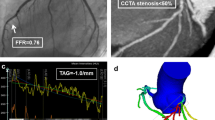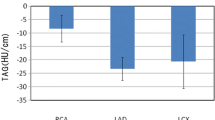Abstract
This study evaluated the feasibility of stress 320 detector CT coronary angiography (CTA) derived transluminal attenuation gradient (TAG320) and contrast opacification (CO) difference to detect hemodynamically significant stenoses as determined by invasive fractional flow reserve (FFR ≤ 0.80). Twenty-seven patients, including 51 vessels on rest CTA were studied. 16 (31 %) vessels were not interpretable on stress CTA largely secondary to motion artefacts. Receiver operating characteristic curve analysis showed a comparable area under the curve (AUC) for rest and stress TAG320 (0.78 and 0.75) which was higher than CTA alone (0.68), and rest and stress CO difference (0.76 and 0.67). Compared with rest CTA, stress CTA demonstrated inferior image quality (Median Likert score 4 vs. 3, P < 0.0001) and required a higher mean radiation exposure (3.2 vs. 5.1 mSv, P < 0.0001). Stress TAG320 and CO difference is less feasible and was not superior in diagnostic performance when compared with rest TAG320 and CO difference.







Similar content being viewed by others
Abbreviations
- CAD:
-
Coronary artery disease
- FFR:
-
Fractional flow reserve
- CTA:
-
CT coronary angiography
- TAG320:
-
Transluminal attenuation gradient
- CO difference:
-
Contrast opacification difference
- PPV:
-
Positive predictive value
- NPV:
-
Negative predictive value
- ROC AUC:
-
Receiver operating characteristics area under curve
References
Budoff MJ, Dowe D, Jollis JG et al (2008) Diagnostic performance of 64-multidetector row coronary computed tomographic angiography for evaluation of coronary artery stenosis in individuals without known coronary artery disease: results from the prospective multicenter ACCURACY (Assessment by Coronary Computed Tomographic Angiography of Individuals Undergoing Invasive Coronary Angiography) trial. J Am Coll Cardiol 52:1724–1732
Meijboom WB, Van Mieghem CA, van Pelt N et al (2008) Comprehensive assessment of coronary artery stenoses: computed tomography coronary angiography versus conventional coronary angiography and correlation with fractional flow reserve in patients with stable angina. J Am Coll Cardiol 52:636–643
Ko BS, Cameron JD, Meredith IT et al (2012) Computed tomography stress myocardial perfusion imaging in patients considered for revascularization: a comparison with fractional flow reserve. Eur Heart J 33:67–77
Bamberg F, Becker A, Schwarz F et al (2011) Detection of hemodynamically significant coronary artery stenosis: incremental diagnostic value of dynamic CT-based myocardial perfusion imaging. Radiology 260:689–698
Choi JH, Min JK, Labounty TM et al (2011) Intracoronary transluminal attenuation gradient in coronary CT angiography for determining coronary artery stenosis. JACC Cardiovasc Imaging 4:1149–1157
Chow BJ, Kass M, Gagne O et al (2011) Can differences in corrected coronary opacification measured with computed tomography predict resting coronary artery flow? J Am Coll Cardiol 57:1280–1288
Wong DT, Ko BS, Cameron JD et al (2013) Transluminal attenuation gradient in coronary computed tomography angiography is a novel noninvasive approach to the identification of functionally significant coronary artery stenosis: a comparison with fractional flow reserve. J Am Coll Cardiol 61:1271–1279
Wong DT, Ko BS, Cameron JD et al (2014) Comparison of diagnostic accuracy of combined assessment using adenosine stress computed tomography perfusion + computed tomography angiography with transluminal attenuation gradient + computed tomography angiography against invasive fractional flow reserve. J Am Coll Cardiol 63:1904–1912
Wong DT, Ko BS, Cameron JD, Meredith IT, Seneviratne SK (2014) Reply: combined CT techniques to assess functionally significant coronary stenosis. J Am Coll Cardiol 64:1404–1405
Ko BS, Cameron JD, Leung M et al (2012) Combined CT coronary angiography and stress myocardial perfusion imaging for hemodynamically significant stenoses in patients with suspected coronary artery disease: a comparison with fractional flow reserve. JACC Cardiovasc Imaging 5:1097–1111
Hausleiter J, Meyer T, Hermann F et al (2009) Estimated radiation dose associated with cardiac CT angiography. JAMA 301:500–507
Mehra VC, Valdiviezo C, Arbab-Zadeh A et al (2011) A stepwise approach to the visual interpretation of CT-based myocardial perfusion. J Cardiovasc Comput Tomogr 5:357–369
Van der Molen AJ, Joemai RM, Geleijns J (2012) Performance of longitudinal and volumetric tube current modulation in a 64-slice CT with different choices of acquisition and reconstruction parameters. Phys Med 28:319–326
Raff GL, Abidov A, Achenbach S et al (2009) SCCT guidelines for the interpretation and reporting of coronary computed tomographic angiography. J Cardiovasc Comput Tomogr 3:122–136
Wong DT, Soh SY, Ko BS et al (2014) Superior CT coronary angiography image quality at lower radiation exposure with second generation 320-detector row CT in patients with elevated heart rate: a comparison with first generation 320-detector row CT. Cardiovasc Diagn Ther 4:299–306
Leipsic J, Labounty TM, Heilbron B et al (2010) Adaptive statistical iterative reconstruction: assessment of image noise and image quality in coronary CT angiography. AJR Am J Roentgenol 195:649–654
Tonino PA, De Bruyne B, Pijls NH et al (2009) Fractional flow reserve versus angiography for guiding percutaneous coronary intervention. N Engl J Med 360:213–224
DeLong ER, DeLong DM, Clarke-Pearson DL (1988) Comparing the areas under two or more correlated receiver operating characteristic curves: a nonparametric approach. Biometrics 44:837–845
Pencina MJ, D’Agostino RB Sr, D’Agostino RB Jr, Vasan RS (2008) Evaluating the added predictive ability of a new marker: from area under the ROC curve to reclassification and beyond. Stat Med 27:157–172 (discussion 207–212)
De Bruyne B, Sarma J (2008) Fractional flow reserve: a review: invasive imaging. Heart 94:949–959
Min JK, Leipsic J, Pencina MJ et al (2012) Diagnostic accuracy of fractional flow reserve from anatomic CT angiography. JAMA 308:1237–1245
Stuijfzand WJ, Danad I, Raijmakers PG et al (2014) Additional value of transluminal attenuation gradient in CT angiography to predict hemodynamic significance of coronary artery stenosis. JACC Cardiovasc Imaging 7:374–386
Yoon YE, Choi JH, Kim JH et al (2012) Noninvasive diagnosis of ischemia-causing coronary stenosis using CT angiography: diagnostic value of transluminal attenuation gradient and fractional flow reserve computed from coronary CT angiography compared to invasively measured fractional flow reserve. JACC Cardiovasc Imaging 5:1088–1096
Acknowledgments
Dr. Ko and Dr. Wong are funded by the National Heart Foundation of Australia and Robertson Family Scholarship.
Funding
DW & BK is supported by National Heart Foundation (Australia) Post-Doctoral-fellowships and Robertson-Family-Research-Cardiologist-Fund.
Author information
Authors and Affiliations
Corresponding author
Ethics declarations
Conflict of interest
Dr. Seneviratne has been an invited speaker at a Toshiba sponsored meeting. Professor Meredith has received honoraria for serving on strategic advisory boards of Boston Scientific and Medtronic. All other authors have reported that they have no relationships relevant to the contents of this paper to disclose.
Rights and permissions
About this article
Cite this article
Ko, B.S., Seneviratne, S., Cameron, J.D. et al. Rest and stress transluminal attenuation gradient and contrast opacification difference for detection of hemodynamically significant stenoses in patients with suspected coronary artery disease. Int J Cardiovasc Imaging 32, 1131–1141 (2016). https://doi.org/10.1007/s10554-016-0867-3
Received:
Accepted:
Published:
Issue Date:
DOI: https://doi.org/10.1007/s10554-016-0867-3




